A Detailed Report on Personal and Professional Development Analysis
VerifiedAdded on 2020/07/22
|15
|4501
|58
Report
AI Summary
This report delves into the realm of personal and professional development, exploring various facets such as self-managed learning approaches, diverse learning styles (including diverging, assimilating, and converging), and strategies for fostering lifelong learning. It highlights the benefits of self-managed learning for both individuals and organizations, detailing how it enhances skills, competitiveness, and overall performance. The report also addresses work-based problems, proposing solutions like effective communication, time management strategies, and the importance of aligning individual skills with organizational objectives. Furthermore, it examines communication methods across different organizational levels and emphasizes the significance of time management techniques for achieving goals efficiently. The report concludes by emphasizing the development of a plan for personal and professional growth, incorporating feedback and evaluation for continuous improvement.
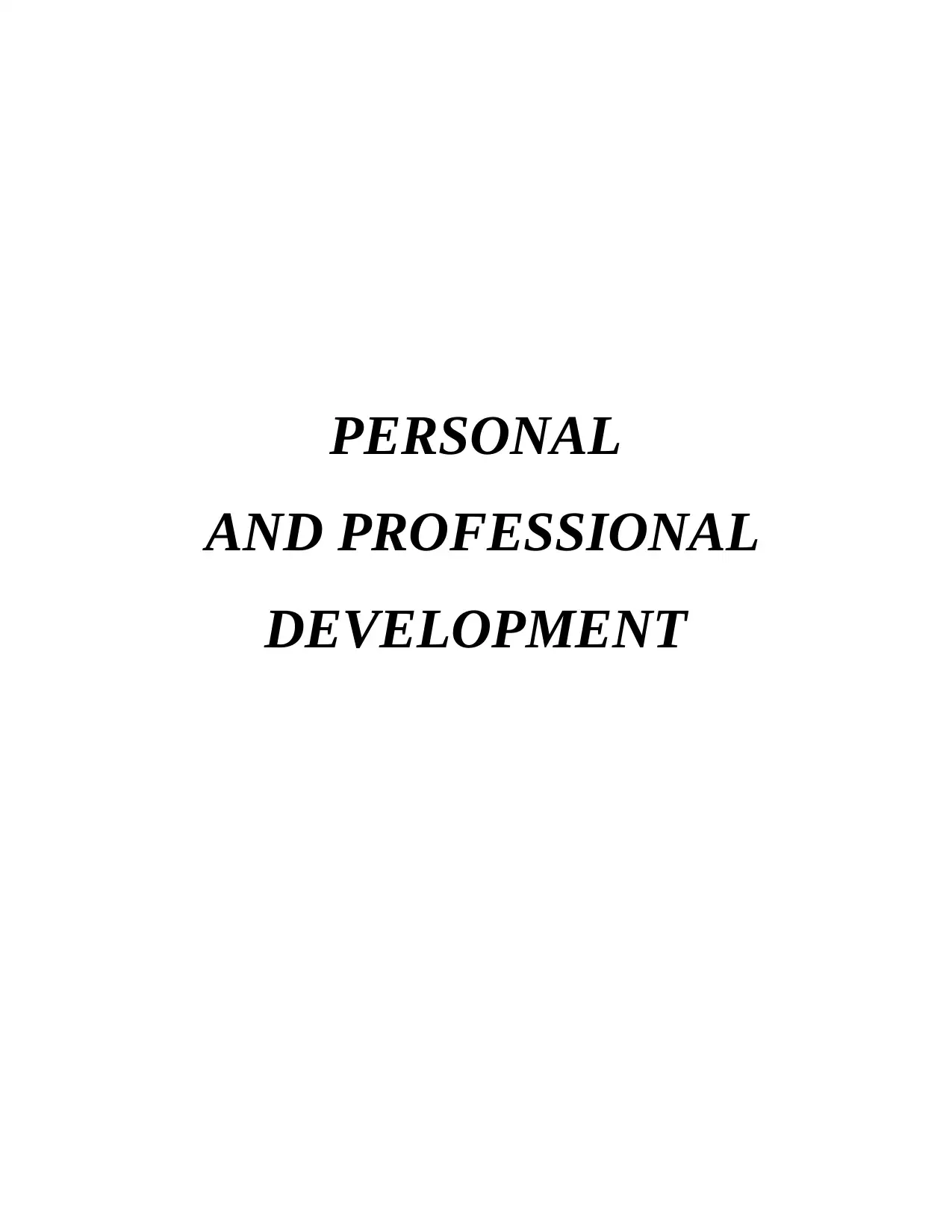
PERSONAL
AND PROFESSIONAL
DEVELOPMENT
AND PROFESSIONAL
DEVELOPMENT
Paraphrase This Document
Need a fresh take? Get an instant paraphrase of this document with our AI Paraphraser
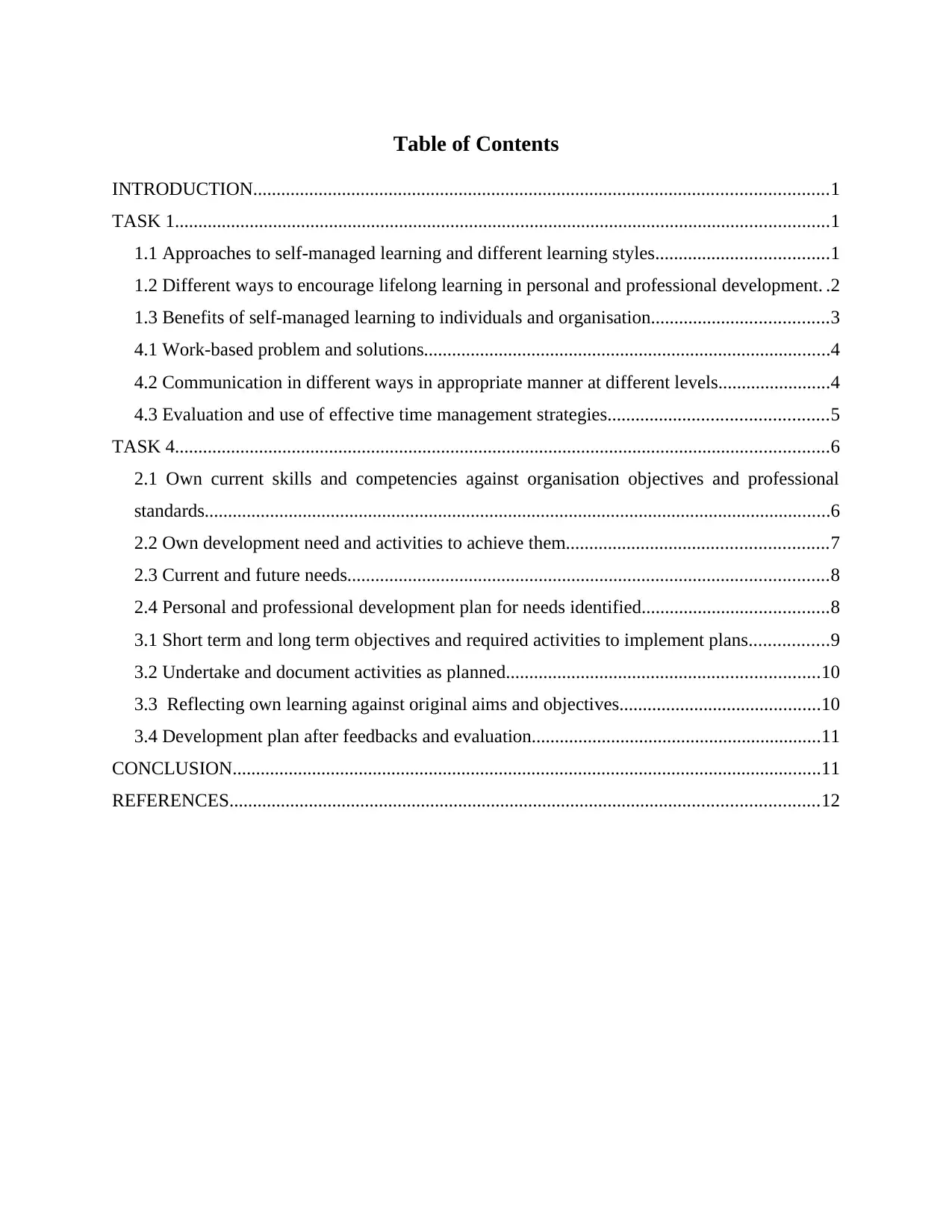
Table of Contents
INTRODUCTION...........................................................................................................................1
TASK 1............................................................................................................................................1
1.1 Approaches to self-managed learning and different learning styles.....................................1
1.2 Different ways to encourage lifelong learning in personal and professional development. .2
1.3 Benefits of self-managed learning to individuals and organisation......................................3
4.1 Work-based problem and solutions.......................................................................................4
4.2 Communication in different ways in appropriate manner at different levels........................4
4.3 Evaluation and use of effective time management strategies...............................................5
TASK 4............................................................................................................................................6
2.1 Own current skills and competencies against organisation objectives and professional
standards......................................................................................................................................6
2.2 Own development need and activities to achieve them........................................................7
2.3 Current and future needs.......................................................................................................8
2.4 Personal and professional development plan for needs identified........................................8
3.1 Short term and long term objectives and required activities to implement plans.................9
3.2 Undertake and document activities as planned...................................................................10
3.3 Reflecting own learning against original aims and objectives...........................................10
3.4 Development plan after feedbacks and evaluation..............................................................11
CONCLUSION..............................................................................................................................11
REFERENCES..............................................................................................................................12
INTRODUCTION...........................................................................................................................1
TASK 1............................................................................................................................................1
1.1 Approaches to self-managed learning and different learning styles.....................................1
1.2 Different ways to encourage lifelong learning in personal and professional development. .2
1.3 Benefits of self-managed learning to individuals and organisation......................................3
4.1 Work-based problem and solutions.......................................................................................4
4.2 Communication in different ways in appropriate manner at different levels........................4
4.3 Evaluation and use of effective time management strategies...............................................5
TASK 4............................................................................................................................................6
2.1 Own current skills and competencies against organisation objectives and professional
standards......................................................................................................................................6
2.2 Own development need and activities to achieve them........................................................7
2.3 Current and future needs.......................................................................................................8
2.4 Personal and professional development plan for needs identified........................................8
3.1 Short term and long term objectives and required activities to implement plans.................9
3.2 Undertake and document activities as planned...................................................................10
3.3 Reflecting own learning against original aims and objectives...........................................10
3.4 Development plan after feedbacks and evaluation..............................................................11
CONCLUSION..............................................................................................................................11
REFERENCES..............................................................................................................................12
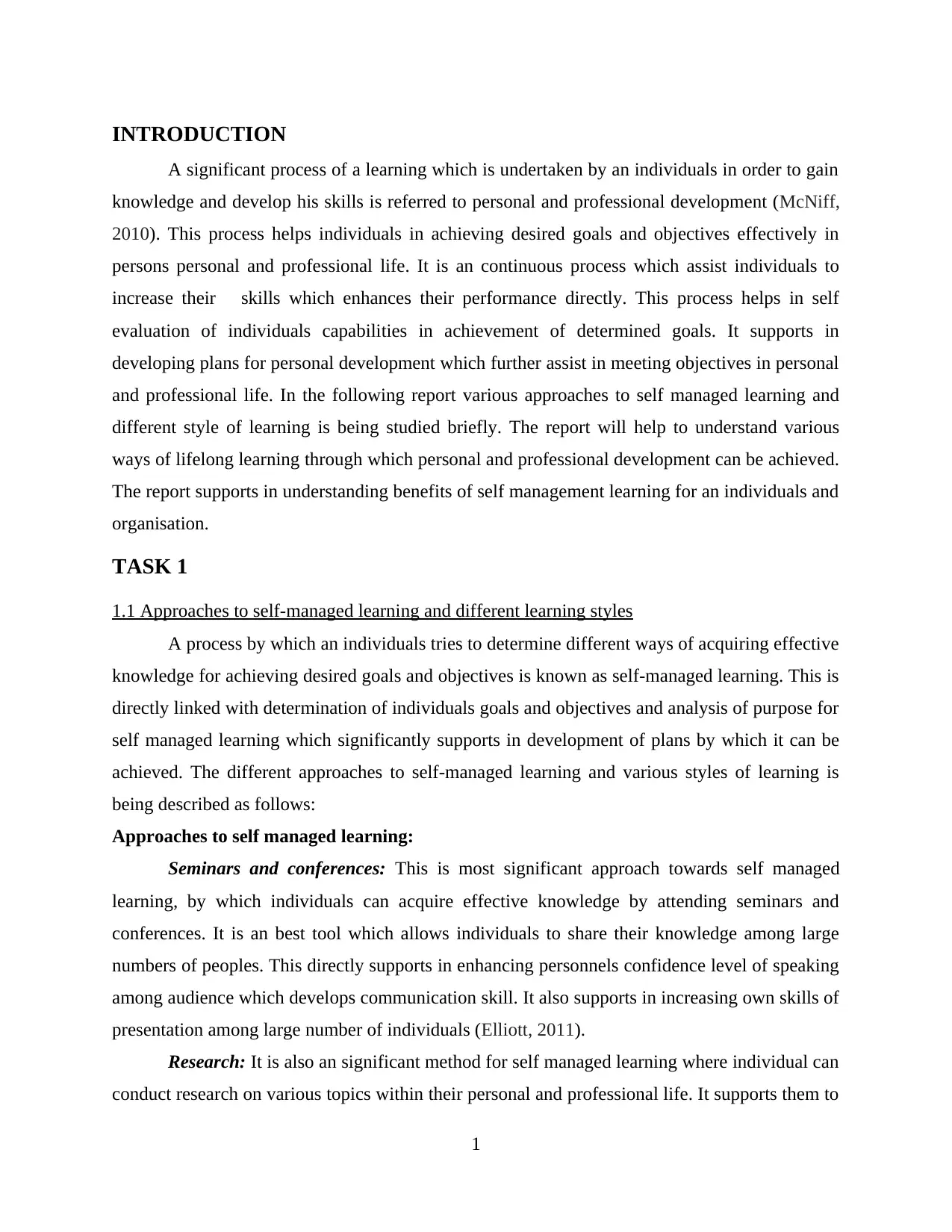
INTRODUCTION
A significant process of a learning which is undertaken by an individuals in order to gain
knowledge and develop his skills is referred to personal and professional development (McNiff,
2010). This process helps individuals in achieving desired goals and objectives effectively in
persons personal and professional life. It is an continuous process which assist individuals to
increase their skills which enhances their performance directly. This process helps in self
evaluation of individuals capabilities in achievement of determined goals. It supports in
developing plans for personal development which further assist in meeting objectives in personal
and professional life. In the following report various approaches to self managed learning and
different style of learning is being studied briefly. The report will help to understand various
ways of lifelong learning through which personal and professional development can be achieved.
The report supports in understanding benefits of self management learning for an individuals and
organisation.
TASK 1
1.1 Approaches to self-managed learning and different learning styles
A process by which an individuals tries to determine different ways of acquiring effective
knowledge for achieving desired goals and objectives is known as self-managed learning. This is
directly linked with determination of individuals goals and objectives and analysis of purpose for
self managed learning which significantly supports in development of plans by which it can be
achieved. The different approaches to self-managed learning and various styles of learning is
being described as follows:
Approaches to self managed learning:
Seminars and conferences: This is most significant approach towards self managed
learning, by which individuals can acquire effective knowledge by attending seminars and
conferences. It is an best tool which allows individuals to share their knowledge among large
numbers of peoples. This directly supports in enhancing personnels confidence level of speaking
among audience which develops communication skill. It also supports in increasing own skills of
presentation among large number of individuals (Elliott, 2011).
Research: It is also an significant method for self managed learning where individual can
conduct research on various topics within their personal and professional life. It supports them to
1
A significant process of a learning which is undertaken by an individuals in order to gain
knowledge and develop his skills is referred to personal and professional development (McNiff,
2010). This process helps individuals in achieving desired goals and objectives effectively in
persons personal and professional life. It is an continuous process which assist individuals to
increase their skills which enhances their performance directly. This process helps in self
evaluation of individuals capabilities in achievement of determined goals. It supports in
developing plans for personal development which further assist in meeting objectives in personal
and professional life. In the following report various approaches to self managed learning and
different style of learning is being studied briefly. The report will help to understand various
ways of lifelong learning through which personal and professional development can be achieved.
The report supports in understanding benefits of self management learning for an individuals and
organisation.
TASK 1
1.1 Approaches to self-managed learning and different learning styles
A process by which an individuals tries to determine different ways of acquiring effective
knowledge for achieving desired goals and objectives is known as self-managed learning. This is
directly linked with determination of individuals goals and objectives and analysis of purpose for
self managed learning which significantly supports in development of plans by which it can be
achieved. The different approaches to self-managed learning and various styles of learning is
being described as follows:
Approaches to self managed learning:
Seminars and conferences: This is most significant approach towards self managed
learning, by which individuals can acquire effective knowledge by attending seminars and
conferences. It is an best tool which allows individuals to share their knowledge among large
numbers of peoples. This directly supports in enhancing personnels confidence level of speaking
among audience which develops communication skill. It also supports in increasing own skills of
presentation among large number of individuals (Elliott, 2011).
Research: It is also an significant method for self managed learning where individual can
conduct research on various topics within their personal and professional life. It supports them to
1
⊘ This is a preview!⊘
Do you want full access?
Subscribe today to unlock all pages.

Trusted by 1+ million students worldwide
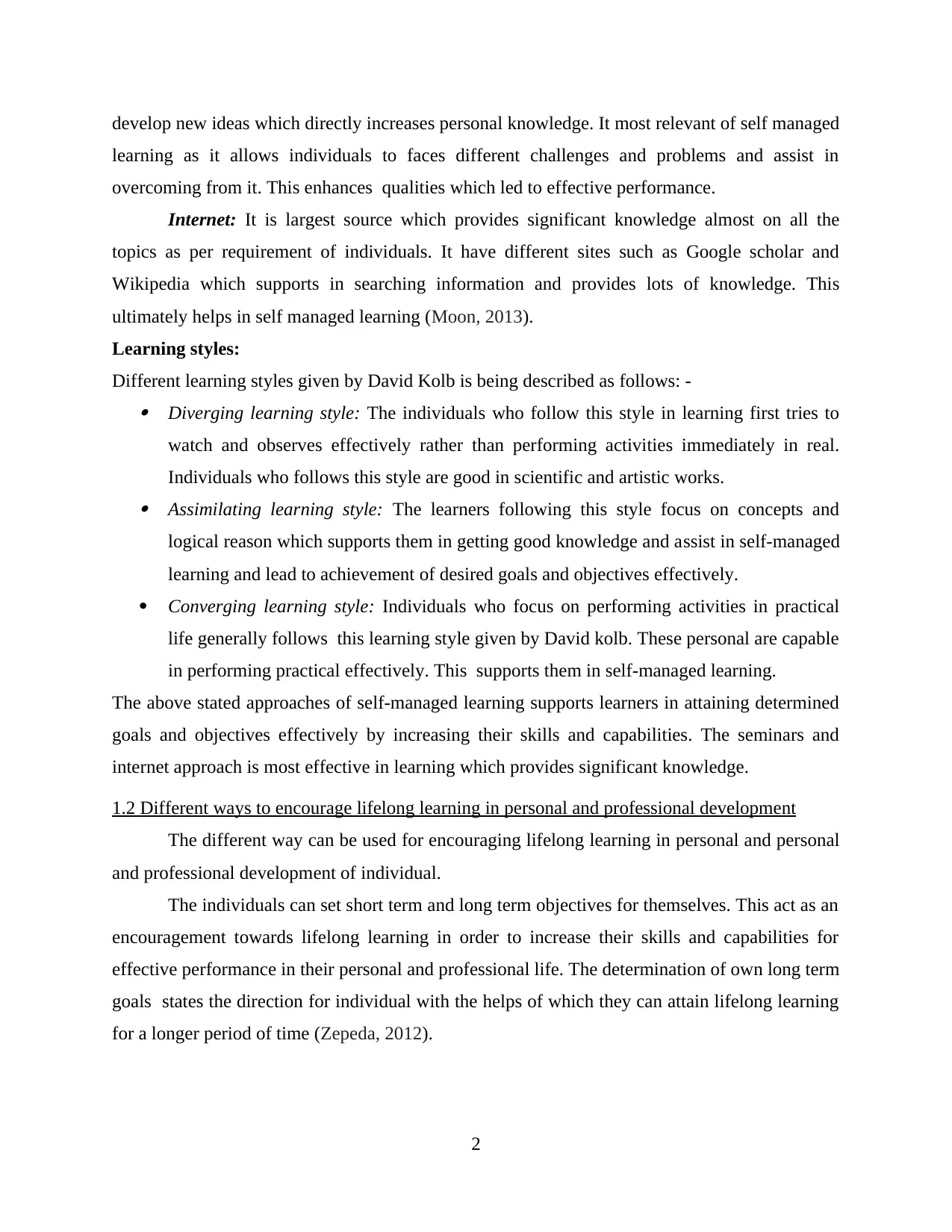
develop new ideas which directly increases personal knowledge. It most relevant of self managed
learning as it allows individuals to faces different challenges and problems and assist in
overcoming from it. This enhances qualities which led to effective performance.
Internet: It is largest source which provides significant knowledge almost on all the
topics as per requirement of individuals. It have different sites such as Google scholar and
Wikipedia which supports in searching information and provides lots of knowledge. This
ultimately helps in self managed learning (Moon, 2013).
Learning styles:
Different learning styles given by David Kolb is being described as follows: - Diverging learning style: The individuals who follow this style in learning first tries to
watch and observes effectively rather than performing activities immediately in real.
Individuals who follows this style are good in scientific and artistic works. Assimilating learning style: The learners following this style focus on concepts and
logical reason which supports them in getting good knowledge and assist in self-managed
learning and lead to achievement of desired goals and objectives effectively.
Converging learning style: Individuals who focus on performing activities in practical
life generally follows this learning style given by David kolb. These personal are capable
in performing practical effectively. This supports them in self-managed learning.
The above stated approaches of self-managed learning supports learners in attaining determined
goals and objectives effectively by increasing their skills and capabilities. The seminars and
internet approach is most effective in learning which provides significant knowledge.
1.2 Different ways to encourage lifelong learning in personal and professional development
The different way can be used for encouraging lifelong learning in personal and personal
and professional development of individual.
The individuals can set short term and long term objectives for themselves. This act as an
encouragement towards lifelong learning in order to increase their skills and capabilities for
effective performance in their personal and professional life. The determination of own long term
goals states the direction for individual with the helps of which they can attain lifelong learning
for a longer period of time (Zepeda, 2012).
2
learning as it allows individuals to faces different challenges and problems and assist in
overcoming from it. This enhances qualities which led to effective performance.
Internet: It is largest source which provides significant knowledge almost on all the
topics as per requirement of individuals. It have different sites such as Google scholar and
Wikipedia which supports in searching information and provides lots of knowledge. This
ultimately helps in self managed learning (Moon, 2013).
Learning styles:
Different learning styles given by David Kolb is being described as follows: - Diverging learning style: The individuals who follow this style in learning first tries to
watch and observes effectively rather than performing activities immediately in real.
Individuals who follows this style are good in scientific and artistic works. Assimilating learning style: The learners following this style focus on concepts and
logical reason which supports them in getting good knowledge and assist in self-managed
learning and lead to achievement of desired goals and objectives effectively.
Converging learning style: Individuals who focus on performing activities in practical
life generally follows this learning style given by David kolb. These personal are capable
in performing practical effectively. This supports them in self-managed learning.
The above stated approaches of self-managed learning supports learners in attaining determined
goals and objectives effectively by increasing their skills and capabilities. The seminars and
internet approach is most effective in learning which provides significant knowledge.
1.2 Different ways to encourage lifelong learning in personal and professional development
The different way can be used for encouraging lifelong learning in personal and personal
and professional development of individual.
The individuals can set short term and long term objectives for themselves. This act as an
encouragement towards lifelong learning in order to increase their skills and capabilities for
effective performance in their personal and professional life. The determination of own long term
goals states the direction for individual with the helps of which they can attain lifelong learning
for a longer period of time (Zepeda, 2012).
2
Paraphrase This Document
Need a fresh take? Get an instant paraphrase of this document with our AI Paraphraser
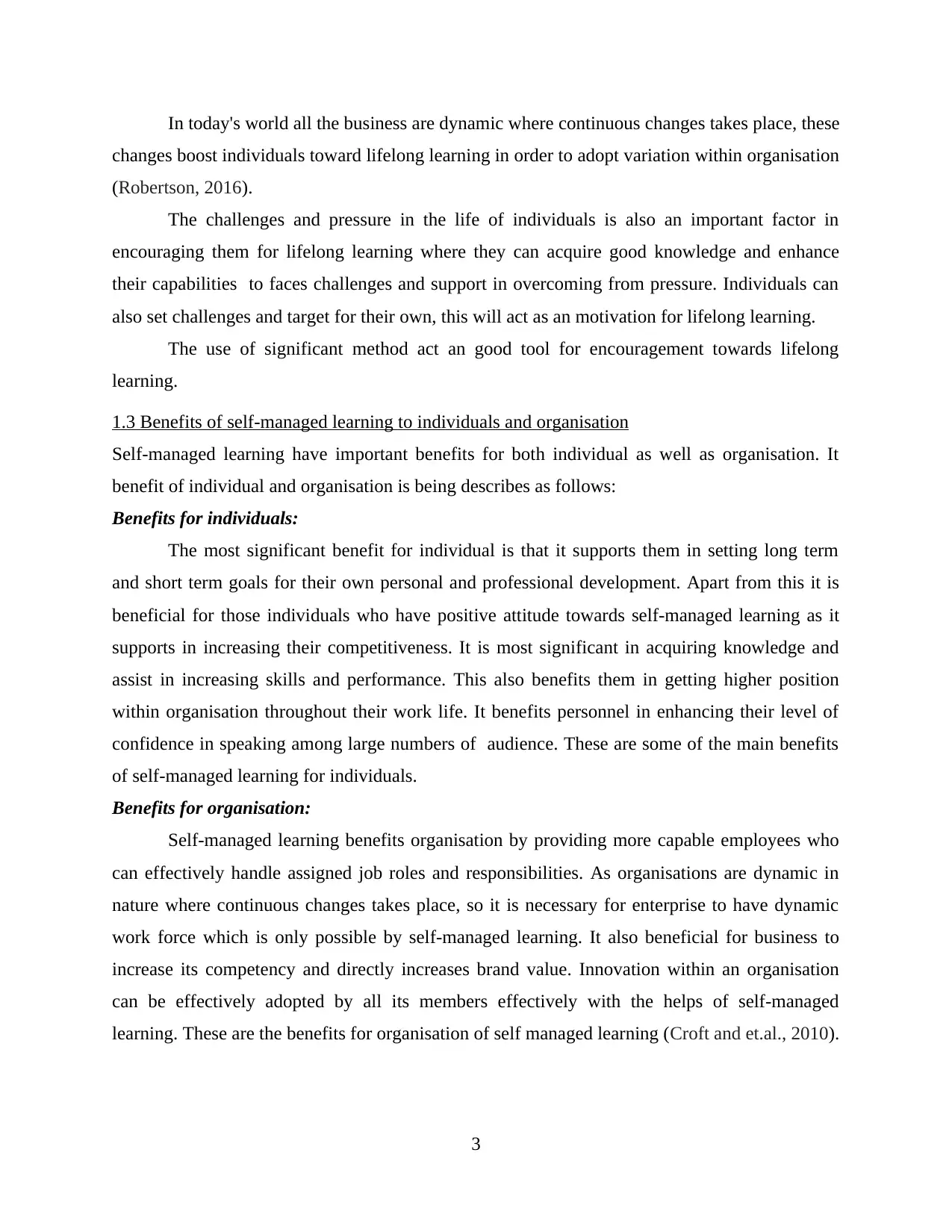
In today's world all the business are dynamic where continuous changes takes place, these
changes boost individuals toward lifelong learning in order to adopt variation within organisation
(Robertson, 2016).
The challenges and pressure in the life of individuals is also an important factor in
encouraging them for lifelong learning where they can acquire good knowledge and enhance
their capabilities to faces challenges and support in overcoming from pressure. Individuals can
also set challenges and target for their own, this will act as an motivation for lifelong learning.
The use of significant method act an good tool for encouragement towards lifelong
learning.
1.3 Benefits of self-managed learning to individuals and organisation
Self-managed learning have important benefits for both individual as well as organisation. It
benefit of individual and organisation is being describes as follows:
Benefits for individuals:
The most significant benefit for individual is that it supports them in setting long term
and short term goals for their own personal and professional development. Apart from this it is
beneficial for those individuals who have positive attitude towards self-managed learning as it
supports in increasing their competitiveness. It is most significant in acquiring knowledge and
assist in increasing skills and performance. This also benefits them in getting higher position
within organisation throughout their work life. It benefits personnel in enhancing their level of
confidence in speaking among large numbers of audience. These are some of the main benefits
of self-managed learning for individuals.
Benefits for organisation:
Self-managed learning benefits organisation by providing more capable employees who
can effectively handle assigned job roles and responsibilities. As organisations are dynamic in
nature where continuous changes takes place, so it is necessary for enterprise to have dynamic
work force which is only possible by self-managed learning. It also beneficial for business to
increase its competency and directly increases brand value. Innovation within an organisation
can be effectively adopted by all its members effectively with the helps of self-managed
learning. These are the benefits for organisation of self managed learning (Croft and et.al., 2010).
3
changes boost individuals toward lifelong learning in order to adopt variation within organisation
(Robertson, 2016).
The challenges and pressure in the life of individuals is also an important factor in
encouraging them for lifelong learning where they can acquire good knowledge and enhance
their capabilities to faces challenges and support in overcoming from pressure. Individuals can
also set challenges and target for their own, this will act as an motivation for lifelong learning.
The use of significant method act an good tool for encouragement towards lifelong
learning.
1.3 Benefits of self-managed learning to individuals and organisation
Self-managed learning have important benefits for both individual as well as organisation. It
benefit of individual and organisation is being describes as follows:
Benefits for individuals:
The most significant benefit for individual is that it supports them in setting long term
and short term goals for their own personal and professional development. Apart from this it is
beneficial for those individuals who have positive attitude towards self-managed learning as it
supports in increasing their competitiveness. It is most significant in acquiring knowledge and
assist in increasing skills and performance. This also benefits them in getting higher position
within organisation throughout their work life. It benefits personnel in enhancing their level of
confidence in speaking among large numbers of audience. These are some of the main benefits
of self-managed learning for individuals.
Benefits for organisation:
Self-managed learning benefits organisation by providing more capable employees who
can effectively handle assigned job roles and responsibilities. As organisations are dynamic in
nature where continuous changes takes place, so it is necessary for enterprise to have dynamic
work force which is only possible by self-managed learning. It also beneficial for business to
increase its competency and directly increases brand value. Innovation within an organisation
can be effectively adopted by all its members effectively with the helps of self-managed
learning. These are the benefits for organisation of self managed learning (Croft and et.al., 2010).
3
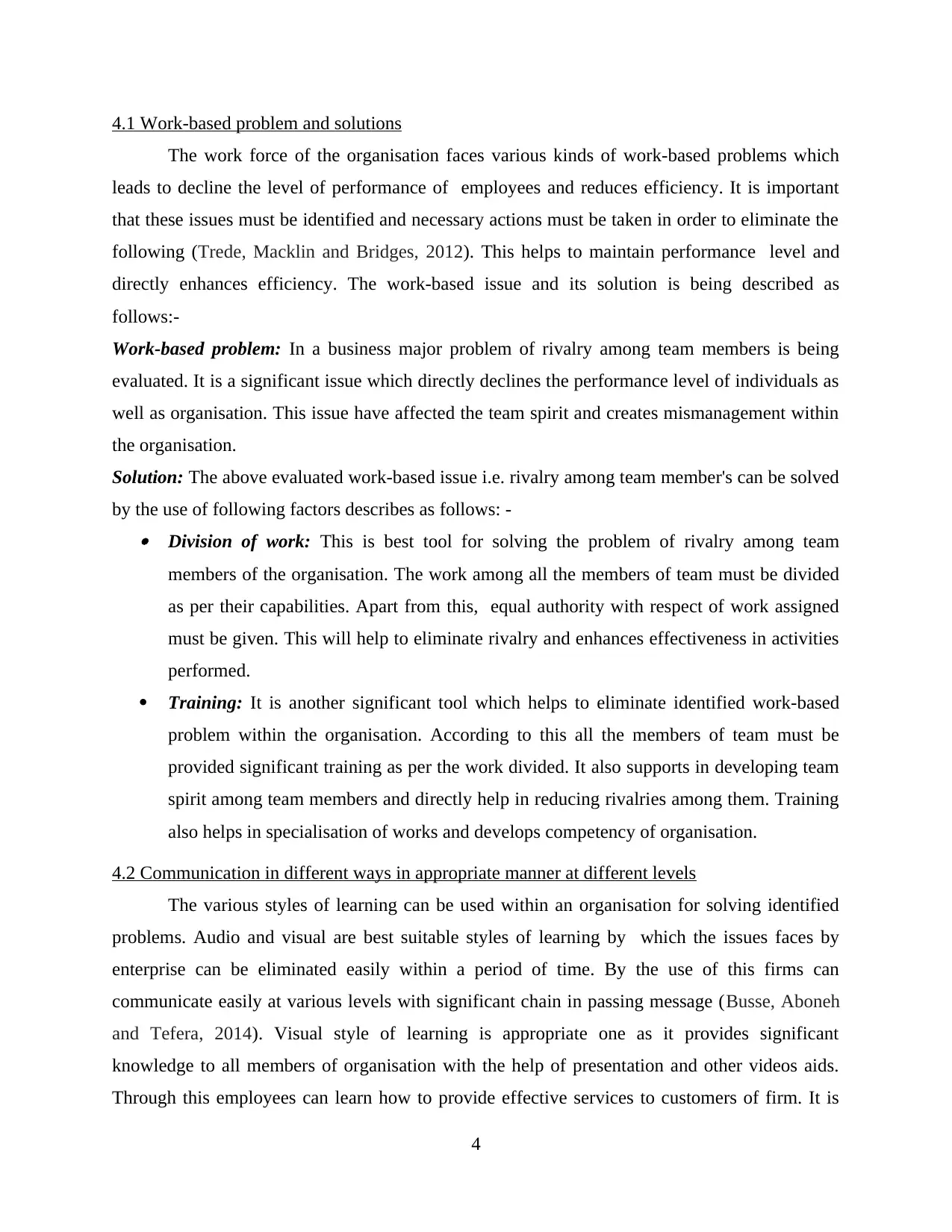
4.1 Work-based problem and solutions
The work force of the organisation faces various kinds of work-based problems which
leads to decline the level of performance of employees and reduces efficiency. It is important
that these issues must be identified and necessary actions must be taken in order to eliminate the
following (Trede, Macklin and Bridges, 2012). This helps to maintain performance level and
directly enhances efficiency. The work-based issue and its solution is being described as
follows:-
Work-based problem: In a business major problem of rivalry among team members is being
evaluated. It is a significant issue which directly declines the performance level of individuals as
well as organisation. This issue have affected the team spirit and creates mismanagement within
the organisation.
Solution: The above evaluated work-based issue i.e. rivalry among team member's can be solved
by the use of following factors describes as follows: - Division of work: This is best tool for solving the problem of rivalry among team
members of the organisation. The work among all the members of team must be divided
as per their capabilities. Apart from this, equal authority with respect of work assigned
must be given. This will help to eliminate rivalry and enhances effectiveness in activities
performed.
Training: It is another significant tool which helps to eliminate identified work-based
problem within the organisation. According to this all the members of team must be
provided significant training as per the work divided. It also supports in developing team
spirit among team members and directly help in reducing rivalries among them. Training
also helps in specialisation of works and develops competency of organisation.
4.2 Communication in different ways in appropriate manner at different levels
The various styles of learning can be used within an organisation for solving identified
problems. Audio and visual are best suitable styles of learning by which the issues faces by
enterprise can be eliminated easily within a period of time. By the use of this firms can
communicate easily at various levels with significant chain in passing message (Busse, Aboneh
and Tefera, 2014). Visual style of learning is appropriate one as it provides significant
knowledge to all members of organisation with the help of presentation and other videos aids.
Through this employees can learn how to provide effective services to customers of firm. It is
4
The work force of the organisation faces various kinds of work-based problems which
leads to decline the level of performance of employees and reduces efficiency. It is important
that these issues must be identified and necessary actions must be taken in order to eliminate the
following (Trede, Macklin and Bridges, 2012). This helps to maintain performance level and
directly enhances efficiency. The work-based issue and its solution is being described as
follows:-
Work-based problem: In a business major problem of rivalry among team members is being
evaluated. It is a significant issue which directly declines the performance level of individuals as
well as organisation. This issue have affected the team spirit and creates mismanagement within
the organisation.
Solution: The above evaluated work-based issue i.e. rivalry among team member's can be solved
by the use of following factors describes as follows: - Division of work: This is best tool for solving the problem of rivalry among team
members of the organisation. The work among all the members of team must be divided
as per their capabilities. Apart from this, equal authority with respect of work assigned
must be given. This will help to eliminate rivalry and enhances effectiveness in activities
performed.
Training: It is another significant tool which helps to eliminate identified work-based
problem within the organisation. According to this all the members of team must be
provided significant training as per the work divided. It also supports in developing team
spirit among team members and directly help in reducing rivalries among them. Training
also helps in specialisation of works and develops competency of organisation.
4.2 Communication in different ways in appropriate manner at different levels
The various styles of learning can be used within an organisation for solving identified
problems. Audio and visual are best suitable styles of learning by which the issues faces by
enterprise can be eliminated easily within a period of time. By the use of this firms can
communicate easily at various levels with significant chain in passing message (Busse, Aboneh
and Tefera, 2014). Visual style of learning is appropriate one as it provides significant
knowledge to all members of organisation with the help of presentation and other videos aids.
Through this employees can learn how to provide effective services to customers of firm. It is
4
⊘ This is a preview!⊘
Do you want full access?
Subscribe today to unlock all pages.

Trusted by 1+ million students worldwide
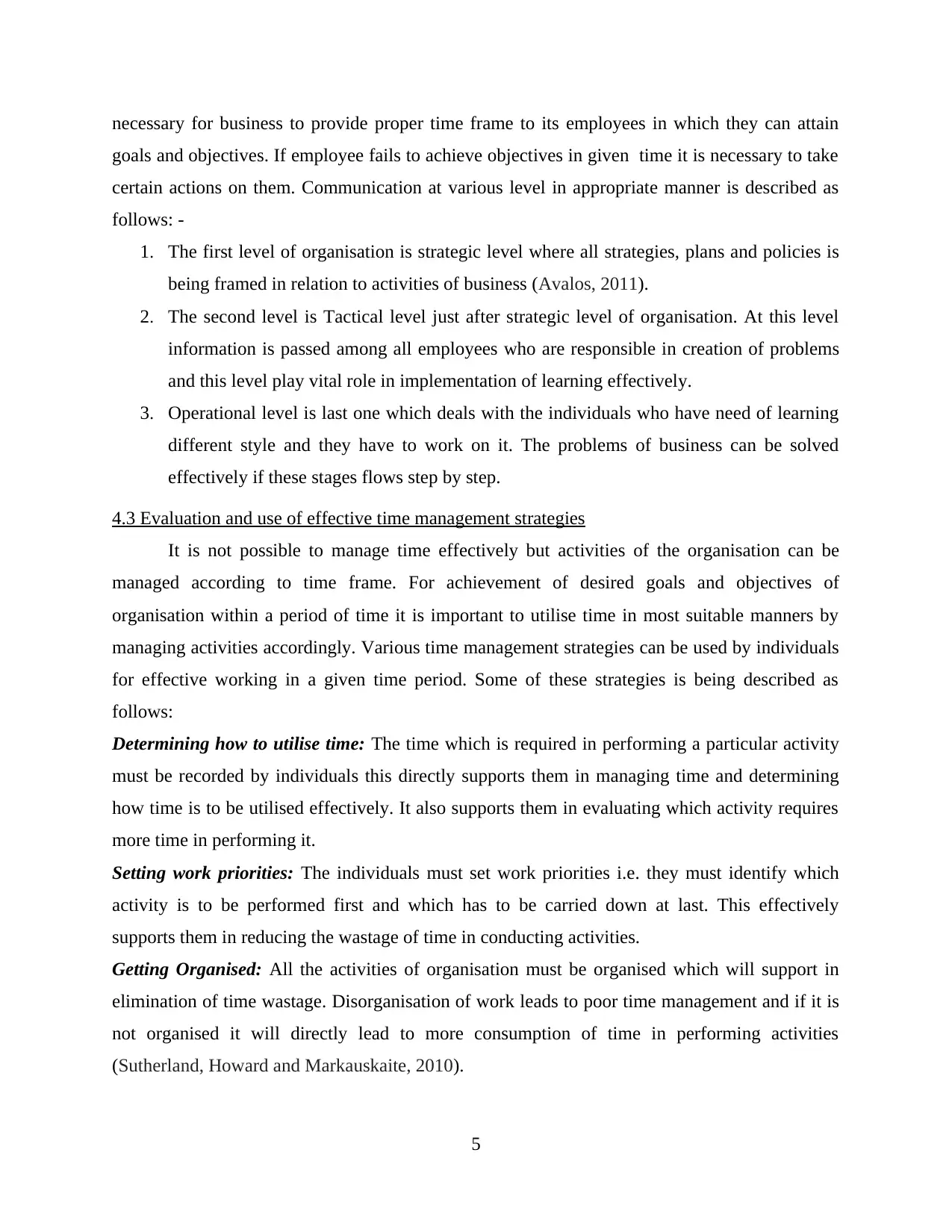
necessary for business to provide proper time frame to its employees in which they can attain
goals and objectives. If employee fails to achieve objectives in given time it is necessary to take
certain actions on them. Communication at various level in appropriate manner is described as
follows: -
1. The first level of organisation is strategic level where all strategies, plans and policies is
being framed in relation to activities of business (Avalos, 2011).
2. The second level is Tactical level just after strategic level of organisation. At this level
information is passed among all employees who are responsible in creation of problems
and this level play vital role in implementation of learning effectively.
3. Operational level is last one which deals with the individuals who have need of learning
different style and they have to work on it. The problems of business can be solved
effectively if these stages flows step by step.
4.3 Evaluation and use of effective time management strategies
It is not possible to manage time effectively but activities of the organisation can be
managed according to time frame. For achievement of desired goals and objectives of
organisation within a period of time it is important to utilise time in most suitable manners by
managing activities accordingly. Various time management strategies can be used by individuals
for effective working in a given time period. Some of these strategies is being described as
follows:
Determining how to utilise time: The time which is required in performing a particular activity
must be recorded by individuals this directly supports them in managing time and determining
how time is to be utilised effectively. It also supports them in evaluating which activity requires
more time in performing it.
Setting work priorities: The individuals must set work priorities i.e. they must identify which
activity is to be performed first and which has to be carried down at last. This effectively
supports them in reducing the wastage of time in conducting activities.
Getting Organised: All the activities of organisation must be organised which will support in
elimination of time wastage. Disorganisation of work leads to poor time management and if it is
not organised it will directly lead to more consumption of time in performing activities
(Sutherland, Howard and Markauskaite, 2010).
5
goals and objectives. If employee fails to achieve objectives in given time it is necessary to take
certain actions on them. Communication at various level in appropriate manner is described as
follows: -
1. The first level of organisation is strategic level where all strategies, plans and policies is
being framed in relation to activities of business (Avalos, 2011).
2. The second level is Tactical level just after strategic level of organisation. At this level
information is passed among all employees who are responsible in creation of problems
and this level play vital role in implementation of learning effectively.
3. Operational level is last one which deals with the individuals who have need of learning
different style and they have to work on it. The problems of business can be solved
effectively if these stages flows step by step.
4.3 Evaluation and use of effective time management strategies
It is not possible to manage time effectively but activities of the organisation can be
managed according to time frame. For achievement of desired goals and objectives of
organisation within a period of time it is important to utilise time in most suitable manners by
managing activities accordingly. Various time management strategies can be used by individuals
for effective working in a given time period. Some of these strategies is being described as
follows:
Determining how to utilise time: The time which is required in performing a particular activity
must be recorded by individuals this directly supports them in managing time and determining
how time is to be utilised effectively. It also supports them in evaluating which activity requires
more time in performing it.
Setting work priorities: The individuals must set work priorities i.e. they must identify which
activity is to be performed first and which has to be carried down at last. This effectively
supports them in reducing the wastage of time in conducting activities.
Getting Organised: All the activities of organisation must be organised which will support in
elimination of time wastage. Disorganisation of work leads to poor time management and if it is
not organised it will directly lead to more consumption of time in performing activities
(Sutherland, Howard and Markauskaite, 2010).
5
Paraphrase This Document
Need a fresh take? Get an instant paraphrase of this document with our AI Paraphraser

Elimination of multi tasking: Time management strategies fails most of the time because of
performing more than one activity simultaneously. The employees of the organisation have
mindset that doing two or more activity at the same time eliminates wastage of time but in facts
it does not. It leads to distraction in work which creates errors in activities performed. These
errors further consumes more time while resolving them (Lamote and Engels, 2010).
TASK 4
2.1 Own current skills and competencies against organisation objectives and professional
standards
Positive Skills (Strengths) Negative skills (Weaknesses)
I have good leadership skills which
supports me in leading members of the
organisation effectively. It also
supports me in creating team spirit
among individuals and creates healthy
environment.
I posses effective management skills
which supports me in managing
activities of business effectively and
eliminates mismanagement from firm
(Jimoyiannis, 2010).
I do not have time management skills
which leads to consumption of more
time and this act as an barrier in my
performances which leads to delay in
attaining objectives.
I lack behind in communication skills
which some time leads to rivalry among
members due to miscommunication.
I do not posses effective writing skills
which acts as an barrier which
communicating with client and
customers in written.
Curriculum vitae
Name:
Address:
Contact Number:
Email ID:
Carrier objective:- To involve in business activities where in can use my skills effectively with
6
performing more than one activity simultaneously. The employees of the organisation have
mindset that doing two or more activity at the same time eliminates wastage of time but in facts
it does not. It leads to distraction in work which creates errors in activities performed. These
errors further consumes more time while resolving them (Lamote and Engels, 2010).
TASK 4
2.1 Own current skills and competencies against organisation objectives and professional
standards
Positive Skills (Strengths) Negative skills (Weaknesses)
I have good leadership skills which
supports me in leading members of the
organisation effectively. It also
supports me in creating team spirit
among individuals and creates healthy
environment.
I posses effective management skills
which supports me in managing
activities of business effectively and
eliminates mismanagement from firm
(Jimoyiannis, 2010).
I do not have time management skills
which leads to consumption of more
time and this act as an barrier in my
performances which leads to delay in
attaining objectives.
I lack behind in communication skills
which some time leads to rivalry among
members due to miscommunication.
I do not posses effective writing skills
which acts as an barrier which
communicating with client and
customers in written.
Curriculum vitae
Name:
Address:
Contact Number:
Email ID:
Carrier objective:- To involve in business activities where in can use my skills effectively with
6
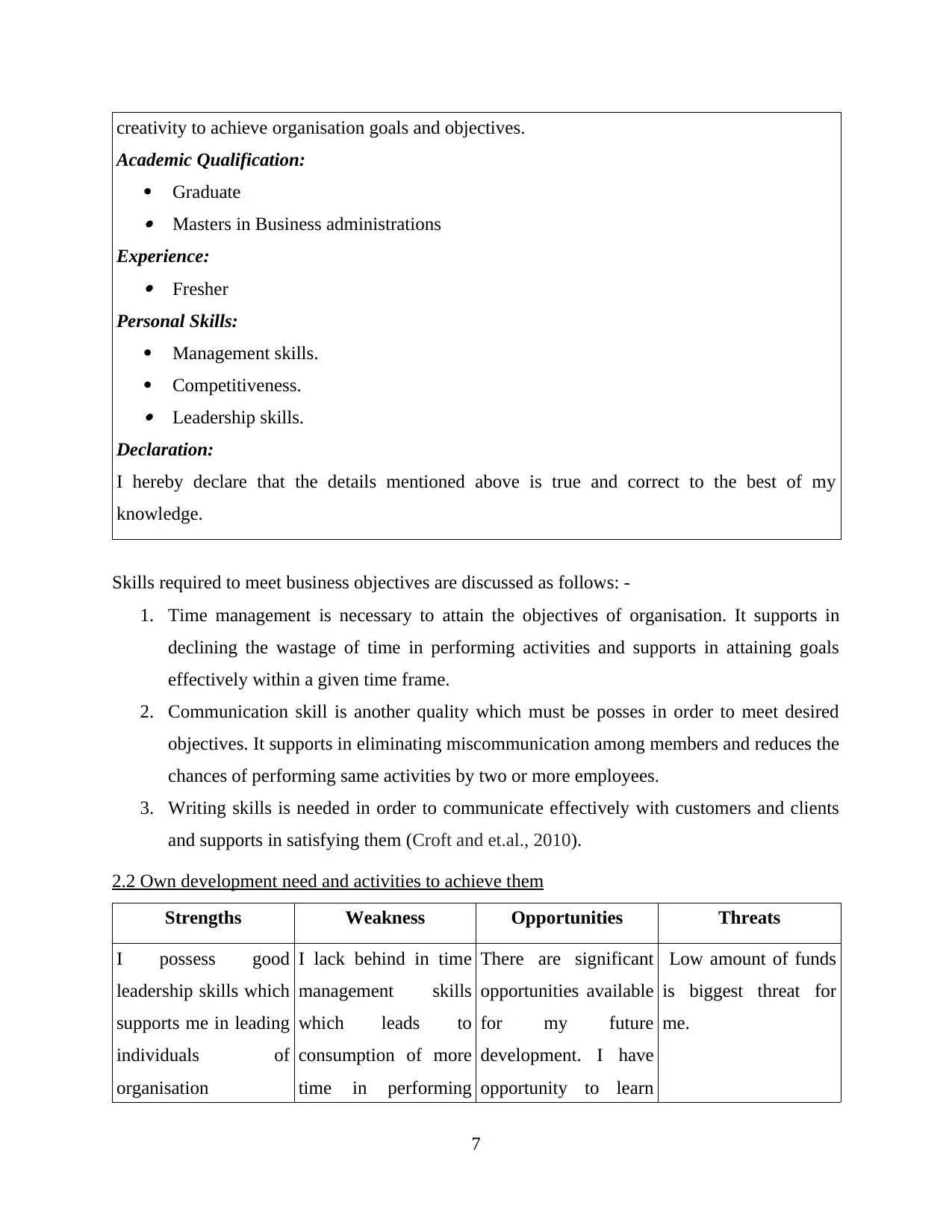
creativity to achieve organisation goals and objectives.
Academic Qualification:
Graduate Masters in Business administrations
Experience: Fresher
Personal Skills:
Management skills.
Competitiveness. Leadership skills.
Declaration:
I hereby declare that the details mentioned above is true and correct to the best of my
knowledge.
Skills required to meet business objectives are discussed as follows: -
1. Time management is necessary to attain the objectives of organisation. It supports in
declining the wastage of time in performing activities and supports in attaining goals
effectively within a given time frame.
2. Communication skill is another quality which must be posses in order to meet desired
objectives. It supports in eliminating miscommunication among members and reduces the
chances of performing same activities by two or more employees.
3. Writing skills is needed in order to communicate effectively with customers and clients
and supports in satisfying them (Croft and et.al., 2010).
2.2 Own development need and activities to achieve them
Strengths Weakness Opportunities Threats
I possess good
leadership skills which
supports me in leading
individuals of
organisation
I lack behind in time
management skills
which leads to
consumption of more
time in performing
There are significant
opportunities available
for my future
development. I have
opportunity to learn
Low amount of funds
is biggest threat for
me.
7
Academic Qualification:
Graduate Masters in Business administrations
Experience: Fresher
Personal Skills:
Management skills.
Competitiveness. Leadership skills.
Declaration:
I hereby declare that the details mentioned above is true and correct to the best of my
knowledge.
Skills required to meet business objectives are discussed as follows: -
1. Time management is necessary to attain the objectives of organisation. It supports in
declining the wastage of time in performing activities and supports in attaining goals
effectively within a given time frame.
2. Communication skill is another quality which must be posses in order to meet desired
objectives. It supports in eliminating miscommunication among members and reduces the
chances of performing same activities by two or more employees.
3. Writing skills is needed in order to communicate effectively with customers and clients
and supports in satisfying them (Croft and et.al., 2010).
2.2 Own development need and activities to achieve them
Strengths Weakness Opportunities Threats
I possess good
leadership skills which
supports me in leading
individuals of
organisation
I lack behind in time
management skills
which leads to
consumption of more
time in performing
There are significant
opportunities available
for my future
development. I have
opportunity to learn
Low amount of funds
is biggest threat for
me.
7
⊘ This is a preview!⊘
Do you want full access?
Subscribe today to unlock all pages.

Trusted by 1+ million students worldwide

effectively and helps
in creating team spirit
among all members I
also possess
significant
management skills
which assist in
eliminating
mismanagement from
organisation and
fosters my
performance level.
activity and declines
work efficiency. Apart
from this I do not
posses effective
communication skill
which some time
creates rivalry among
members due to
miscommunication
(Croft and et.al.,
2010).
from other individuals
and different sources.
Activities to meet own development needs:
Training: I have undergone through various training sessions which helps me to get significant
knowledge and support me in overcoming from my weakness i.e. lack of communication skills.
Research: I have made research on various topics of time management which have supported me
in attaining knowledge how time wastage can be eliminated (Blair, 2016).
2.3 Current and future needs.
Current needs Future needs
Currently I have a need to develop my
communication skills in order to eliminate
miscommunication from the organisation
which will support in reducing rivalry among
members. Apart from this, in present situation
I have significant need to develop my time
management skill in order to complete and
achieve objectives of organisation within time
frame.
I have set my future needs i.e. to develop my
personality which supports me in gaining
higher position in organisation. In future I have
need to develop decision making skills which
will support me in taking effective decision
quickly.
8
in creating team spirit
among all members I
also possess
significant
management skills
which assist in
eliminating
mismanagement from
organisation and
fosters my
performance level.
activity and declines
work efficiency. Apart
from this I do not
posses effective
communication skill
which some time
creates rivalry among
members due to
miscommunication
(Croft and et.al.,
2010).
from other individuals
and different sources.
Activities to meet own development needs:
Training: I have undergone through various training sessions which helps me to get significant
knowledge and support me in overcoming from my weakness i.e. lack of communication skills.
Research: I have made research on various topics of time management which have supported me
in attaining knowledge how time wastage can be eliminated (Blair, 2016).
2.3 Current and future needs.
Current needs Future needs
Currently I have a need to develop my
communication skills in order to eliminate
miscommunication from the organisation
which will support in reducing rivalry among
members. Apart from this, in present situation
I have significant need to develop my time
management skill in order to complete and
achieve objectives of organisation within time
frame.
I have set my future needs i.e. to develop my
personality which supports me in gaining
higher position in organisation. In future I have
need to develop decision making skills which
will support me in taking effective decision
quickly.
8
Paraphrase This Document
Need a fresh take? Get an instant paraphrase of this document with our AI Paraphraser
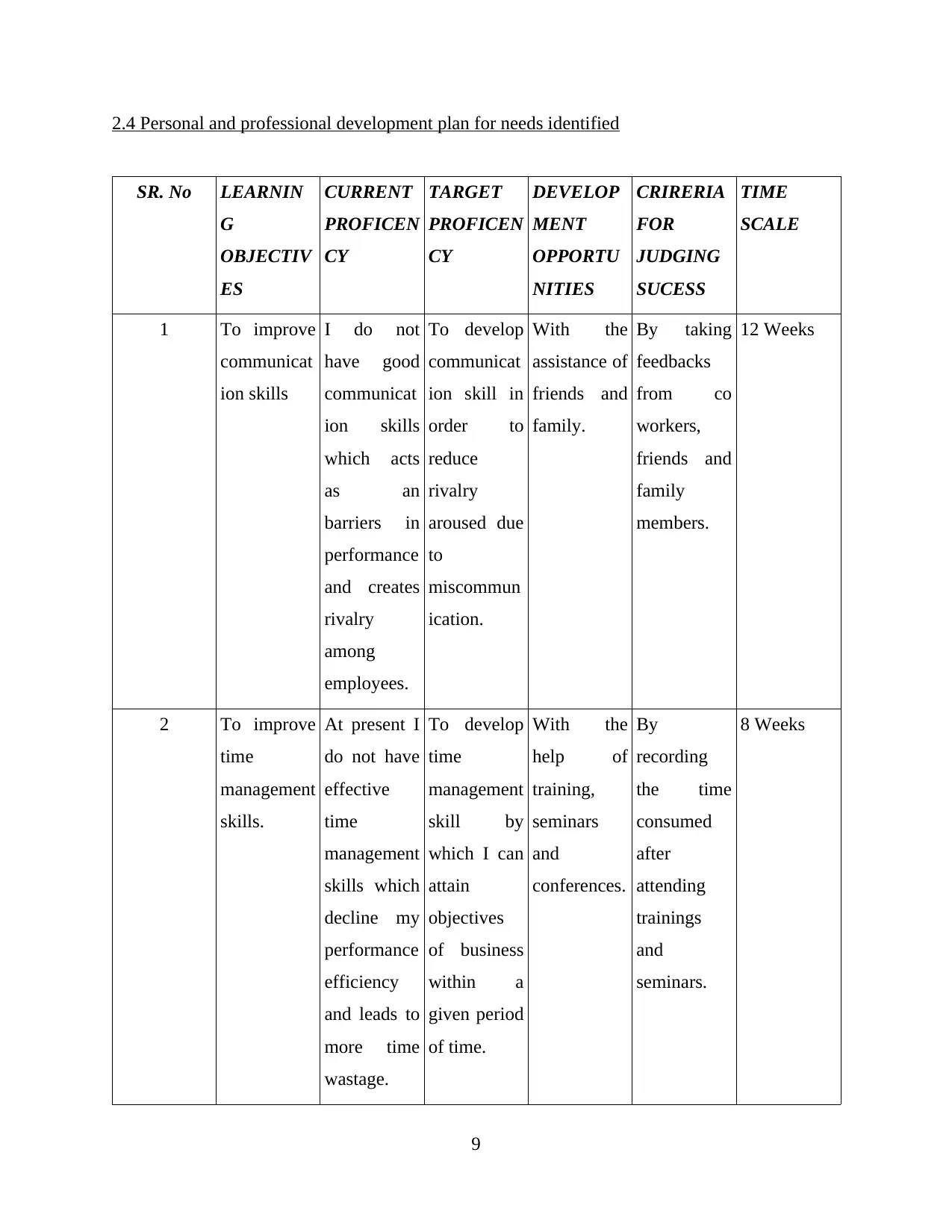
2.4 Personal and professional development plan for needs identified
SR. No LEARNIN
G
OBJECTIV
ES
CURRENT
PROFICEN
CY
TARGET
PROFICEN
CY
DEVELOP
MENT
OPPORTU
NITIES
CRIRERIA
FOR
JUDGING
SUCESS
TIME
SCALE
1 To improve
communicat
ion skills
I do not
have good
communicat
ion skills
which acts
as an
barriers in
performance
and creates
rivalry
among
employees.
To develop
communicat
ion skill in
order to
reduce
rivalry
aroused due
to
miscommun
ication.
With the
assistance of
friends and
family.
By taking
feedbacks
from co
workers,
friends and
family
members.
12 Weeks
2 To improve
time
management
skills.
At present I
do not have
effective
time
management
skills which
decline my
performance
efficiency
and leads to
more time
wastage.
To develop
time
management
skill by
which I can
attain
objectives
of business
within a
given period
of time.
With the
help of
training,
seminars
and
conferences.
By
recording
the time
consumed
after
attending
trainings
and
seminars.
8 Weeks
9
SR. No LEARNIN
G
OBJECTIV
ES
CURRENT
PROFICEN
CY
TARGET
PROFICEN
CY
DEVELOP
MENT
OPPORTU
NITIES
CRIRERIA
FOR
JUDGING
SUCESS
TIME
SCALE
1 To improve
communicat
ion skills
I do not
have good
communicat
ion skills
which acts
as an
barriers in
performance
and creates
rivalry
among
employees.
To develop
communicat
ion skill in
order to
reduce
rivalry
aroused due
to
miscommun
ication.
With the
assistance of
friends and
family.
By taking
feedbacks
from co
workers,
friends and
family
members.
12 Weeks
2 To improve
time
management
skills.
At present I
do not have
effective
time
management
skills which
decline my
performance
efficiency
and leads to
more time
wastage.
To develop
time
management
skill by
which I can
attain
objectives
of business
within a
given period
of time.
With the
help of
training,
seminars
and
conferences.
By
recording
the time
consumed
after
attending
trainings
and
seminars.
8 Weeks
9

3.1 Short term and long term objectives and required activities to implement plans
Short term objectives: On the basis of my weakness I have determined some short term
objectives which are to be attained immediately. I have two short term objectives which are
developing communication skills and time management skills. For I will conduct research and I
will go through various training programs (Stenfors-Hayes and et.al., 2010).
Long term objectives: My long term objective is to develop new qualities such as change
management skills and decision making skills. This development of new skills will help me in
my both personal and professional life.
Activities to implement plans:
Focus on main objective of plan: The individual of organisation must focus on main motive of
plan prepared before implementing it(Maskit, 2011).
Relationship between plan and its link with other activities: The relation of plan with other
activities of organisation must be evaluates before implementation.
Implementation: After conducting above mentioned stage by taking proper training plan must
be implemented.
Impact: It is last step after implementation under this evaluation of implemented plan must be
done (Trede, Macklin and Bridges, 2012).
3.2 Undertake and document activities as planned
As per the above determined objectives for my personal and professional development. It
is important to carry out certain activities for attaining them and developing my skills. The below
mentioned are the activities through which I will follow for my skills development.
1. Firstly for achieving my long term objectives I will attend various training sessions and
seminars also I will conduct research on different topics. The knowledge achieved from
these activities I will implement them in practical life to get benefits out of it.
2. I will attend different time management seminars conducted by experts for my
development of skills.
3.3 Reflecting own learning against original aims and objectives
By evaluation of various learning styles I have frame objectives for my own personal
and professional development. This have to be achieved within short of time frame. For attaining
these different sources are identified by me which helps in gaining effective knowledge. After
this I will go through these sources with complete dedication and hard work for acquiring
10
Short term objectives: On the basis of my weakness I have determined some short term
objectives which are to be attained immediately. I have two short term objectives which are
developing communication skills and time management skills. For I will conduct research and I
will go through various training programs (Stenfors-Hayes and et.al., 2010).
Long term objectives: My long term objective is to develop new qualities such as change
management skills and decision making skills. This development of new skills will help me in
my both personal and professional life.
Activities to implement plans:
Focus on main objective of plan: The individual of organisation must focus on main motive of
plan prepared before implementing it(Maskit, 2011).
Relationship between plan and its link with other activities: The relation of plan with other
activities of organisation must be evaluates before implementation.
Implementation: After conducting above mentioned stage by taking proper training plan must
be implemented.
Impact: It is last step after implementation under this evaluation of implemented plan must be
done (Trede, Macklin and Bridges, 2012).
3.2 Undertake and document activities as planned
As per the above determined objectives for my personal and professional development. It
is important to carry out certain activities for attaining them and developing my skills. The below
mentioned are the activities through which I will follow for my skills development.
1. Firstly for achieving my long term objectives I will attend various training sessions and
seminars also I will conduct research on different topics. The knowledge achieved from
these activities I will implement them in practical life to get benefits out of it.
2. I will attend different time management seminars conducted by experts for my
development of skills.
3.3 Reflecting own learning against original aims and objectives
By evaluation of various learning styles I have frame objectives for my own personal
and professional development. This have to be achieved within short of time frame. For attaining
these different sources are identified by me which helps in gaining effective knowledge. After
this I will go through these sources with complete dedication and hard work for acquiring
10
⊘ This is a preview!⊘
Do you want full access?
Subscribe today to unlock all pages.

Trusted by 1+ million students worldwide
1 out of 15
Related Documents
Your All-in-One AI-Powered Toolkit for Academic Success.
+13062052269
info@desklib.com
Available 24*7 on WhatsApp / Email
![[object Object]](/_next/static/media/star-bottom.7253800d.svg)
Unlock your academic potential
Copyright © 2020–2025 A2Z Services. All Rights Reserved. Developed and managed by ZUCOL.





